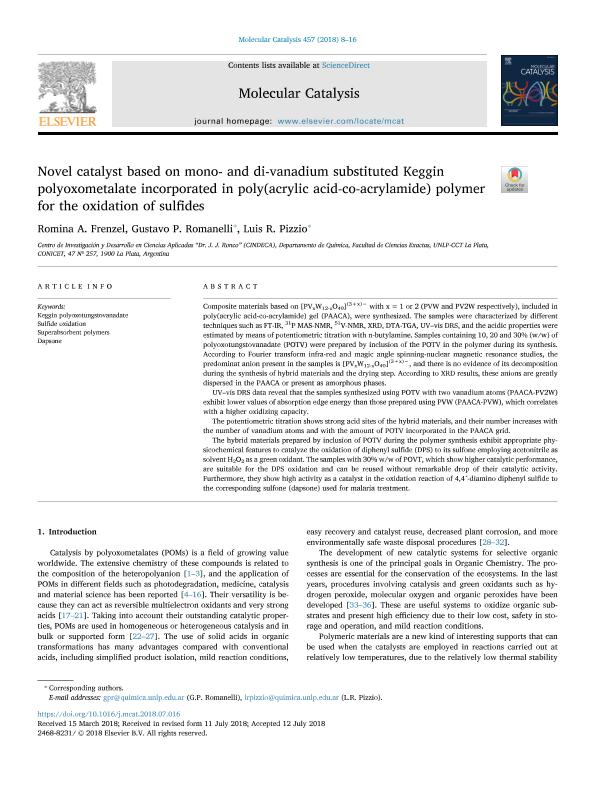Artículo
Novel catalyst based on mono- and di-vanadium substituted Keggin polyoxometalate incorporated in poly(acrylic acid-co-acrylamide) polymer for the oxidation of sulfides
Fecha de publicación:
10/2018
Editorial:
Elsevier Science
Revista:
Molecular Catalysis
ISSN:
2468-8231
Idioma:
Inglés
Tipo de recurso:
Artículo publicado
Clasificación temática:
Resumen
Composite materials based on [PVxW12-xO40](3+x)− with x = 1 or 2 (PVW and PV2W respectively), included in poly(acrylic acid-co-acrylamide) gel (PAACA), were synthesized. The samples were characterized by different techniques such as FT-IR, 31P MAS-NMR, 51V-NMR, XRD, DTA-TGA, UV–vis DRS, and the acidic properties were estimated by means of potentiometric titration with n-butylamine. Samples containing 10, 20 and 30% (w/w) of polyoxotungstovanadate (POTV) were prepared by inclusion of the POTV in the polymer during its synthesis. According to Fourier transform infra-red and magic angle spinning-nuclear magnetic resonance studies, the predominat anion present in the samples is [PVxW12-xO40](3+x)−, and there is no evidence of its decomposition during the synthesis of hybrid materials and the drying step. According to XRD results, these anions are greatly dispersed in the PAACA or present as amorphous phases. UV–vis DRS data reveal that the samples synthesized using POTV with two vanadium atoms (PAACA-PV2W) exhibit lower values of absorption edge energy than those prepared using PVW (PAACA-PVW), which correlates with a higher oxidizing capacity. The potentiometric titration shows strong acid sites of the hybrid materials, and their number increases with the number of vanadium atoms and with the amount of POTV incorporated in the PAACA grid. The hybrid materials prepared by inclusion of POTV during the polymer synthesis exhibit appropriate physicochemical features to catalyze the oxidation of diphenyl sulfide (DPS) to its sulfone employing acetonitrile as solvent H2O2 as a green oxidant. The samples with 30% w/w of POVT, which show higher catalytic performance, are suitable for the DPS oxidation and can be reused without remarkable drop of their catalytic activity. Furthermore, they show high activity as a catalyst in the oxidation reaction of 4,4´-diamino diphenyl sulfide to the corresponding sulfone (dapsone) used for malaria treatment.
Archivos asociados
Licencia
Identificadores
Colecciones
Articulos(CINDECA)
Articulos de CENTRO DE INV EN CS.APLICADAS "DR.JORGE J.RONCO"
Articulos de CENTRO DE INV EN CS.APLICADAS "DR.JORGE J.RONCO"
Citación
Frenzel, Romina Alejandra; Romanelli, Gustavo Pablo; Pizzio, Luis Rene; Novel catalyst based on mono- and di-vanadium substituted Keggin polyoxometalate incorporated in poly(acrylic acid-co-acrylamide) polymer for the oxidation of sulfides; Elsevier Science; Molecular Catalysis; 457; 10-2018; 8-16
Compartir
Altmétricas




